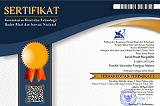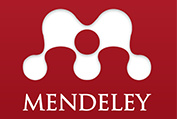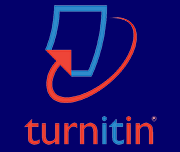Penerapan Silvo-apifisheries dalam pengembangan Ekowisata Pendidikan di Sekitar Hutan Lindung Gunung Ambawang-Pemancing (HL-GAP) Kubu Raya
Abstract
The priority problem that needs to be overcome in Sungai Deras Village by the PKM team is to restore vegetation lost by land clearing activities in order to maintain the protection function of the area. The availability of nectar from flowering vegetation as a source of feed for kelulut bees cultivated by residents is still limited, the availability of sufficient feed will affect the volume and quality of honey produced. The knowledge of community members related to the technology and management of kelulut honey cultivation is still relatively low. In addition, the tourist area in Sungai Deras village needs the addition of better attractions and promotions so that it is increasingly known and in demand by the wider community in West Kalimantan and at the national level. The purpose of this community empowerment activity is expected that honey bee cultivation can also be of tourist attraction value by making the land around existing tourist sites into kelulut cultivation land. This business is not only economic, ecologically also has educational value because it can be used as a location for practice and research for students, lecturers and the general public who want to learn about forest ecosystems and kelulut bee cultivation while traveling (Ecoedutourism). The solution offered by the PKM team is to organize and plant to enrich the number and type of vegetation feed for kelulut bees using an integrated cultivation pattern between forestry, bees and fisheries in one location (SIlvoapifisheries) which also has ecotourism and educational values. PKM activities consist of technical guidance on kelulut cultivation, installing 20 kelulut colonies in stup which will be further developed communally, revegetating the land around kelulut cultivation with types of fruit, flower and medicinal plants. It is hoped that the enrichment of vegetation and cultivating kelulut can maintain the function of protection control and increase community income from the tourism sector.
Keywords
Full Text:
PDF (Bahasa Indonesia)References
Achyani, & Wicandra, D. (2019). Kiat Praktis Budidaya Lebah Trigona (Heterotrigona itama). CV. Laduny Alifatama .
Aisyah Amini, N., Puspadewi Wulandari, Y., Kurniawan Joshi, L., & Djabbar, H. (2022). Inovasi Budidaya Lebah Kelulut Menuju Eduwisata Unggul Di Desa Sangatta Selatan, Kec. Sangatta Selatan, Kabupaten Kutai Timur (Innovation of Kelulut Bee Cultivation Towards Prime Edutourism in South Sangatta Village, South Sangatta District, East Kutai Regency). Jurnal Resolusi Konflik, CSR, Dan Pemberdayaan, 7(1), 25–35.
Alia Mawaddah, G., Nur Agistni Eriana, N., Indah Swari, F., & Aslamiah, S. (2018). Madu Lebah Kelulut (Trigona Spp.) Dalam Aktifitas Terhadap Bakteri Staphylococcus aureus Resisten. Jurnal Skala Kesehatan , 9(1).
Apridamayanti, P., & Normagiat, S. (2021). Kandungan Fenol, Flavonoid Total, dan Aktivitas Antioksidan Sediaan Infusa dan Freeze-dried Infusa Tanaman Plocoglottis lowii Rchb.f. Pharmaceutical Journal of Indonesia, 18(01), 122–129.
Basari, N., Ramli, S. N., & Khairi, N. ‘Aina S. M. (2018). Food reward and distance influence the foraging pattern of stingless bee, heterotrigona itama. Insects, 9(4). https://doi.org/10.3390/insects9040138
Benedick, S., Gansau, J. A., & Ahmad, A. H. (2021). Foraging Behaviour of Heterotrigona itama (Apidae: Meliponini) in Residential Areas. Pertanika Journal of Tropical Agricultural Science, 44(2), 485–502. https://doi.org/10.47836/PJTAS.44.2.13
Chandra, R. A., & Irwansyah. (2023). Pengembangan Kualitas Produk Dalam Upaya Meningkatkan Volume Penjualan Produk Home Industry Madu Lebah Kelulut “Nano Alami.” Jurnal Bisnis Dan Pembangunan, 12(3), 54–61.
Fatoni, A., Made Artika, I., & Endang Zainal Hasan, A. (2008). Antibacterial Activity of Propolis Produced by Trigona spp. Against Campylobacter spp. HAYATI Journal of Biosciences, 15(4), 161–164.
Heryandi, Qurniati, R., Darmawan, A., & Yuliasari, V. (2022). Agroforestry for biodiversity and climate change mitigation in Batutegi Protection Forest, Lampung, Indonesia. Biodiversitas, 23(3), 1611–1620. https://doi.org/10.13057/biodiv/d230352
Hidayah, Z., Utama, R. Y. S., As-Syakur, A. R., Rachman, H. A., & Wiyanto, D. B. (2024, February). Mapping mangrove above ground carbon stock of benoa bay bali using sentinel-1 satellite imagery. In IOP Conference Series: Earth and Environmental Science (Vol. 1298, No. 1, p. 012013). IOP Publishing.
Idha Wijaya, N., Trisyani, N., & Sulestiani, A. (2019). Potensi Pengembangan Budidaya Silvofishery Di Area Mangrove Wonorejo Surabaya. Jurnal Penelitian Hutan Dan Konservasi Alam, 16(2), 173–189. https://doi.org/10.20886/jphka.2019.16.2.173-189
Ilham, M. A., Roslinda, E., & Darwati, H. (2023). Kelayakan Usaha Budidaya Trigona sp. Msme Studi Kasus Umkm Asy-Syura Di Desa Galang Kecamatan Sungai Pinyuh Kabupaten Mempawah. Jurnal Hutan Lestari , 11(3), 745–758.
Ismail, N. I., Rafiq, M., Kadir, A., Zulkifli, R., & Mohamed, M. (2021). COMPARISON OF PHYSICOCHEMICAL, TOTAL PROTEIN AND ANTIOXIDANT PROFILES BETWEEN MALAYSIAN Apis AND Trigona HONEYS. Malaysian Journal of Analytical Sciences, 25(2), 243–256. https://www.researchgate.net/publication/351264554
Lugina, M., Indartik, I., Pribadi, M., & Wibowo, A. (2021, May 19). Development of Agroforestry-Based Ecotourism in RPH Mangunan, KPH Yogyakarta. Proceedings of the 1st International Conference on Sustainable Management and Innovation. https://doi.org/10.4108/eai.14-9-2020.2304457
Meinhold, K., & Darr, D. (2021). Using a multi-stakeholder approach to increase value for traditional agroforestry systems: the case of baobab (Adansonia digitata L.) in Kilifi, Kenya. Agroforestry Systems, 95(7), 1343–1358. https://doi.org/10.1007/s10457-020-00562-x
Nazri Janra, M., Herwina, H., & Salmah, S. (2020). Identifikasi Potensi Predator dan Hama pada Peternakan Kelulut (Hymenoptera; Apidae; Meliponini; Tetragonula, Lepidotrigona) melalui Pengamatan Cepat di Kabupaten Padang Pariaman, Sumatera Barat I. Jurnal Sumberdaya HAYATI, 6(2), 67–74. https://journal.ipb.ac.id/index.php/sumberdayahayati
Nengsi, B., Evahelda, E., & Purwasih, R. (2022). Pengaruh Bauran Pemasaran terhadap Keputusan Pembelian Inovasi Madu Kelulut di Kecamatan Manggar Kabupaten Belitung Timur. Jurnal Studi Inovasi, 2(3), 9–17. https://doi.org/10.52000/jsi.v2i3.98
Priawandiputra, W., Azizi, M. G., Rismayanti, Djakaria, K. M., Wicaksono, A., Raffiudin, R., Atmowidi, T., & Buchori, D. (2021). Panduan Budidaya Lebah Tanpa Sengat (Stingless Bees) di Desa Perbatasan Hutan: Studi di Lubuk Bintialo dan Pangkalan Bulian, Sumatera Selatan (W. Priawandiputra, Ed.; pertama). ZSL Indonesia.
Qomariyah, L., Arisandi, A., Hidayah, Z., & Farid, A. (2023). Kajian Morfometrik dan Tingkat Kematangan Gonad Rajungan (Portunus pelagicus) di Pagagan Pamekasan. Akuatika Indonesia, 8(2), 87-95.
Rianti, Y., & Purwati, W. (2019). Potensi Tumbuhan Obat Di Desa Bemban Kawasan Hutan Lindung Gunung Ambawang Kecamatan Kubu Kabupaten Kubu Raya (Potential of medicinal plants in Bemban Village in the protected forest area of Gunung Ambawang of Kubu Subdistrict, Kubu Raya Regency). Jurnal Hutan Lestari, 7(3), 1470–1477.
Salita, F., Aswandi, A., & Zuhdi, M. (2022). Impact of Agroforestry On Hydrological Functions In The Batang Merao Hulu (Micro Watershed) Bremas District, Jambi Province. Jurnal Pembangunan Berkelanjutan, 5(1), 46–55. https://doi.org/10.22437/jpb.v5i1.18629
Senoaji, G., Fajrin Hidayat, M., Anwar, G., Lukman, A. H., Susanti, D. E., Kehutanan, J., Pertanian, F., Bengkulu, U., Supratman, J. W. R., Limun, K., Lingkungan Hidup, D., Kehutanan, D., & Bengkulu, P. (2022). Revegetasi Lahan Miring dengan Agroforestri Tanaman Unggulan Lokal untuk Mengurangi Erosi dan Peningkatan Ekonomi di Desa Arga Indah I, Bengkulu Tengah. Indonesian Journal of Community Empowerrment and Services, 2(1), 36–41. https://doi.org/10.33369/icomes.v2i1.2
Sidiq, H., Meiardhy, M., Arbainsyah, A., & Ramlan, A. (2020). Meliponikultur | Petunjuk praktis. Yayasan Swaraowa, Environmental Leadership and Training Initiative (ELTI), Tropenbos Indonesia, Goodhope Asia Holdings Ltd. . https://www.goodhopeholdings.com/
Syaifudin, S. M., & Normagiat, S. (2020). Budidaya Pakan Lebah Trigona sp. dengan Apiculture Agroforestry System di Kelurahan Anjungan Melancar, Kecamatan Anjungan Kabupaten Mempawah. Jurnal Ilmiah Pangabdhi, 6(1), 17–24. https://doi.org/10.21107/pangabdhi.v6i1.6932
Tyas, D. W., Rosaji, F. S. C., Marfai, M. A., & Khakhim, N. (2019). Spatial Modeling for Silvofishery and Greenbelt to Reduce the Risk of Sea Level Rise in Indramayu Coastal Area, West Java-Indonesia. Proceedings of the Pakistan Academy of Sciences, 29–39.
Van Le, M., Kartikawati, S. M., & Manurung, T. F. (2019). Fitogeografi Pasak Bumi (Eurycoma longifolia, Jack) Pada Kawasan Hutan Lindung Gunung Ambawang Bukit Bendera Kabupaten Kubu Raya Kalimantan Barat. Jurnal Hutan Lestari , 7(1), 363–371.
Wahyuningsih, E., Januardi, J., Rusdianto, R., Aswani, D., Apriani, W. A., Nurvaningsih, R., Ainurrofiq, A., Sunarti, D. A., Wahyuni, R., Firdaus, A. R., Aini, N. L., & Wardani, F. B. (2022). Model Penataan Jenis Tanaman Berbasis Home Garden Mendukung Kelestarian Sumber Pakan Trigona. Jurnal PEPADU , 3(4).
Wahyuningtyas, R. S., Halwany, W., Siswadi, S., Hakim, S. S., Rahmanto, B., Lestari, F., Basiang, H. A., Alamsyah, M. S., Susianto, A., Buwono, D. C., Suryanto, E., Effendy, M., Prianto, E., Fahrudin, Al Aqili, I. K., Warhamni, Yusuf, M., & Suriani. (2021). Variation of kelulut (Heterotrigona itama) habitat landscapes in South Kalimantan. IOP Conference Series: Earth and Environmental Science, 918(1). https://doi.org/10.1088/1755-1315/918/1/012004
DOI: https://doi.org/10.21107/pangabdhi.v10i1.22636
Refbacks
- There are currently no refbacks.
Copyright (c) 2024 Sigit Normagiat

This work is licensed under a Creative Commons Attribution-ShareAlike 4.0 International License.
Jurnal Ilmiah Pangabdhi by Universitas Trunojoyo Madura is licensed under a Creative Commons Attribution-ShareAlike 4.0 International License.













